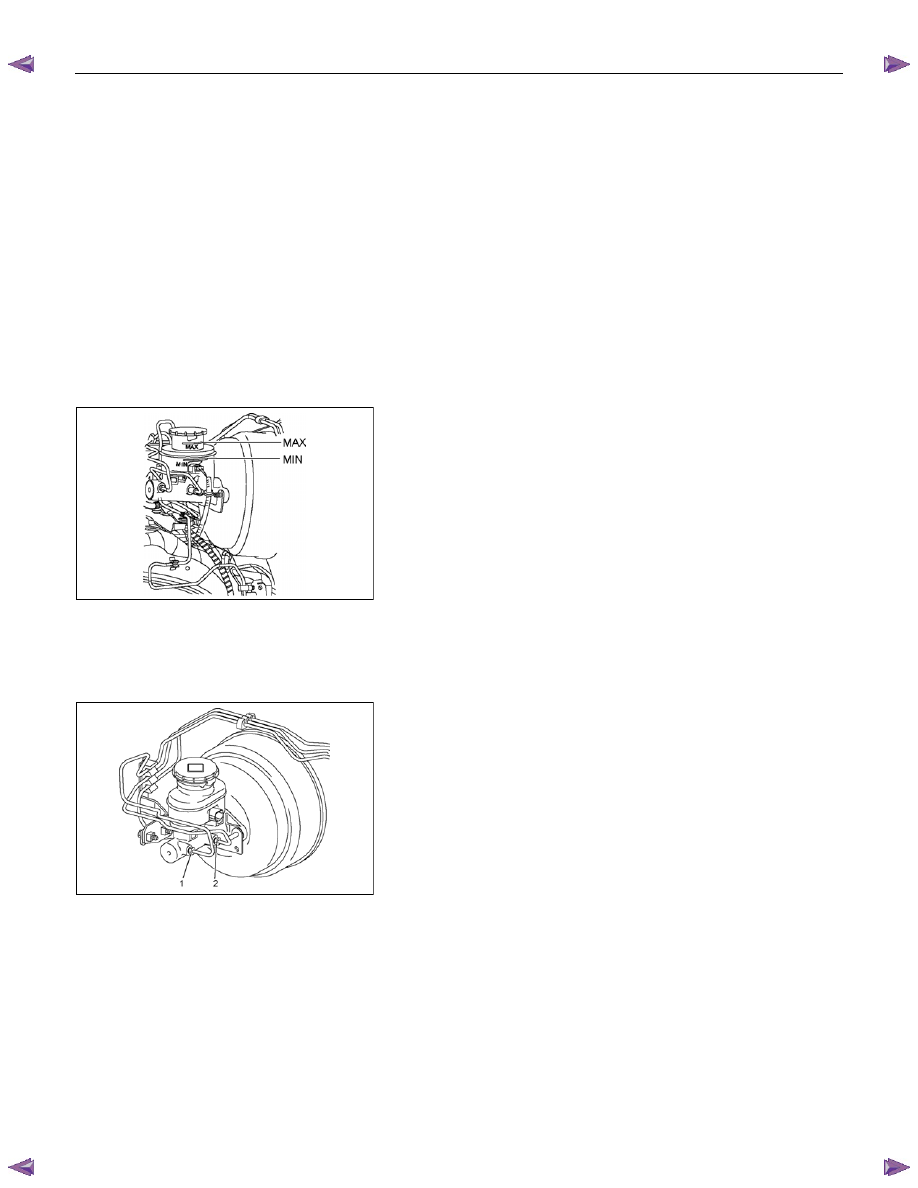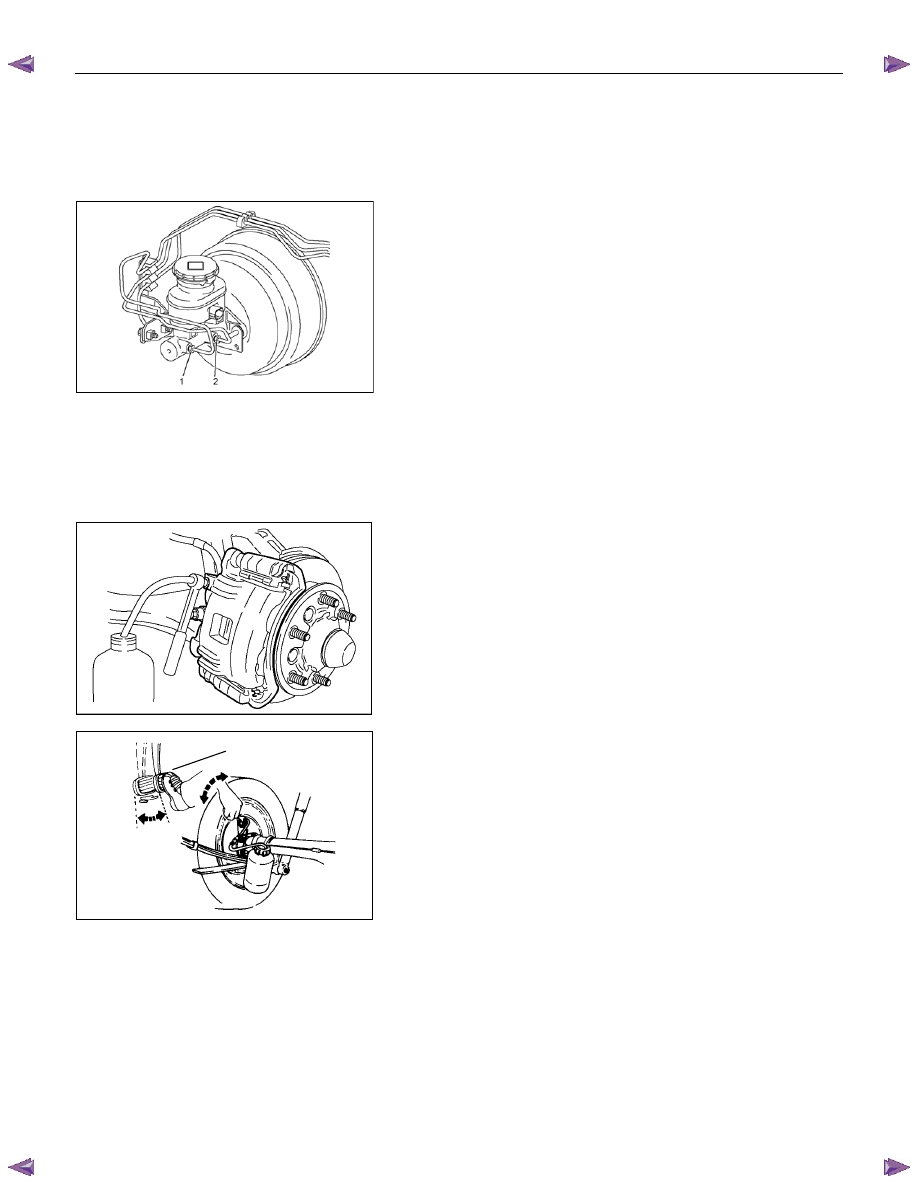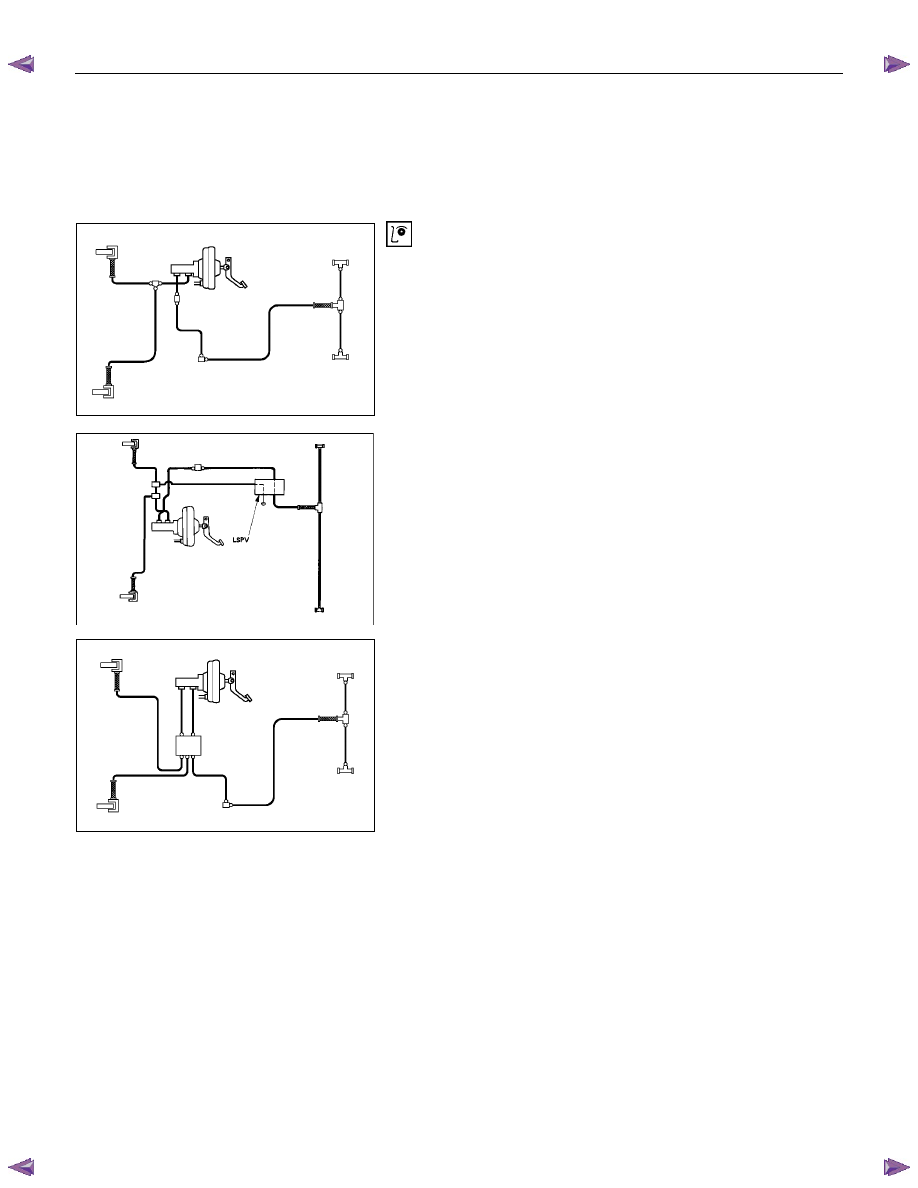Isuzu KB P190. Manual — part 181
BRAKES 5C-25
Filling Master Cylinder Reservoir
CAUTION:
Use only specified brake fluid. Do not use any fluid which
contains a petroleum base. Do not use a container which
has been used for petroleum based fluids or a container
which is wet with water. Petroleum based fluid will cause
swelling and distortion of rubber parts in the hydraulic
brake system. Water mixed with brake fluid lowers the
fluid boiling point. Keep all fluid containers capped to
prevent contamination.
Always fill the master cylinder reservoir when the engine
is cold.
Never allow the brake fluid to come in contact with the
painted surfaces.
The master cylinder reservoir must be kept properly filled
to ensure adequate reserve and to prevent air and
moisture from entering the hydraulic system. However,
because of expansion due to heat absorbed from the
brakes and the engine, the reservoir must not be
overfilled. Thoroughly clean reservoir cap before removal
to avoid getting dirt into reservoir. Add fluid as required to
bring level to the “MAX” mark on the reservoir tank. Use
“DOT 3” Hydraulic Brake Fluid.
Leakage of Brake Fluid
With engine idling, set shift lever in the neutral position and
continue to depress brake pedal at a constant pedal
application force.
Should the pedal stroke become deeper gradually, leakage
from the hydraulic pressure system is possible.
Make sure by visual check that there is no leak.
BLEEDING OF THE BRAKE HYDRAULIC
CIRCUIT
If air enters the bake lines, it will cause poor brake action.
Therefore, bleeding should be performed if the brakes have
been used with the level of brake fluid in the reservoir
excessively low or if brake pipes have been disconnected in
the course of brake servicing.
The bleeding operation calls for co-operative action of 2
persons.
• Set the parking brake firmly while bleeding.
• Perform bleeding operation with ENGINE RUNNING, to
prevent damage to push rod seal.
Make sure exhaust is suitably ventilated.
• Bleed the hydraulic system with the fluid reservoir filled to
the specified level.
• Bleed the system starting with the rear wheel cylinder
farthest from the master cylinder.

5C-26 BRAKES
A bleeding operation is necessary to remove air from the
hydraulic brake system whenever air is introduced into the
hydraulic system. It may be necessary to bleed the hydraulic
system at all four brakes if air has been introduced through a
low fluid level or by disconnecting brake pipes at the master
cylinder. If a brake pipe is disconnected at one wheel, only that
wheel cylinder/caliper needs to be bled. If the pipes are
disconnected at any fitting located between the master cylinder
and brakes, then the brake system served by the disconnected
pipe must be bled.
1. Set the parking brake completely, then start the engine.
NOTE:
The vacuum booster will be damaged if the bleeding operation
is performed with the engine off.
2. Remove the master cylinder reservoir cap.
RTW75CSH001701
3. Fill the master cylinder reservoir with brake fluid. Keep the
reservoir at least half full during the air bleeding operation.
4. Always use new brake fluid for replenishment.
5. In replenishing brake fluid, take care that air bubbles do not
enter the brake fluid.
When the master cylinder is replaced or overhauled, first
bleed the air from the master cylinder, then from each
wheel cylinder and caliper following the procedures
described below.
RTW75CSH001801
Bleeding the Master Cylinder
6. Disconnect the rear wheel brake pipe (1) from the master
cylinder.
Check the fluid level and replenish as necessary. If
replenished, leave the system for at least one minute.
7. Depress the brake pedal slowly once and hold it depressed.
8. Completely seal the delivery port of the master cylinder with
your finger, where the pipe was disconnected, then release
the brake pedal slowly.
9. Release your finger from the delivery port when the brake
pedal returns completely.
10. Repeat steps 7 through 9 until the brake fluid comes out of
the delivery port during step 7.
NOTE: Do not allow the fluid level in the reservoir to go below
the half-way mark.
11. Reconnect the brake pipe (1) to the master cylinder and
tighten the pipe.
12. Depress the brake pedal slowly once and hold it depressed.
13. Loosen the rear wheel brake pipe (1) at the master cylinder.
14.
Retighten the brake pipe, then release the brake pedal
slowly.

BRAKES 5C-27
15. Repeat steps 12 through 14 until no air comes out of the
port when the brake pipe is loosened
NOTE: Be very careful not to allow the brake fluid to come in
contact with painted surfaces.
RTW75CSH001801
16. Bleed the air from the front wheel brake pipe connection (2)
by repeating steps 6 through 15.
Bleeding the Caliper
17. Bleed the air from each wheel in the order listed below:
• Right rear wheel cylinder
• Left rear wheel cylinder
• Left front caliper
• Right front caliper
Conduct air bleeding from the wheels in the above order. If
no brake fluid comes out, it suggests that air is mixed in the
master cylinder. In this case, bleed air from the master
cylinder in accordance with steps 6 through 16, and then
bleed air from the caliper or wheel cylinder.
RTW35CSH000501
18.
Place the proper size box end wrench over the bleeder
screw.
19.
Cover the bleeder screw with a transparent tube, and
submerge the free end of the transparent tube in a
transparent container containing brake fluid.
3
5042
20.
Pump the brake pedal (3) slowly three times (once/sec),
then hold it depressed.
21. Loosen the bleeder screw until fluid flows through the tube.
22. Retighten the bleeder screw.
23. Release the brake pedal slowly.
24.
Repeat steps 20 through 23 until the air is completely
removed.
It may be necessary to repeat the bleeding procedure 10 or
more times for front wheels and 15 or more times for rear
wheels.
25. Go to the next wheel in the sequence after each wheel is
bled.
Be sure to monitor reservoir fluid level.
26. Depress the brake pedal to check if you feel “sponginess”
after the air has been removed from all wheel cylinders and
calipers.
If the pedal feels “spongy” the entire bleeding procedure
must be repeated.

5C-28 BRAKES
27. After the bleeding operation is completed on each individual
wheel, check the level of the brake fluid in the reservoir and
replenish up to the “MAX" level as necessary.
28. Attach the reservoir cap.
29. Stop the engine.
05007-1
BRAKE LINE (HOSES AND PIPES)
• Inspect all hoses and pipes for wear, bending, chafing,
cracks, dents, or any other damage.
Make necessary correction or replace parts if these
abnormal conditions are found through inspection.
• All hoses, pipes and joints can be damaged easily.
Do not allow the hose to become excessively twisted and
bent when working with them, and pay special attention to
all the brake lines not to damage them when repairing or
replacing other parts (axle, suspension, etc).
• Inspection for leakage should be performed by depressing
the brake pedal fully.
If leakage is apparent at the circumference of joints,
retighten or replace these parts.
This procedure must be performed whenever brake lines
are installed.
• After disconnecting the hoses and pipes, cap or tape the
openings to prevent entry of foreign material.

Нет комментариевНе стесняйтесь поделиться с нами вашим ценным мнением.
Текст